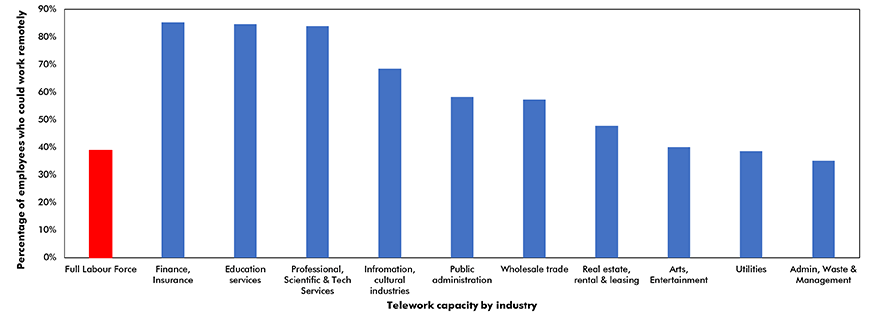The forced migration of office workers from multi-storied office towers to home offices in multi-storied condominiums or single-family homes to try and prevent the spread of COVID-19 has prompted some to declare that working from home will become the norm or, at least, a much more popular work venue for many. This prospect was raised both by the Globe and Mail in an article titled, Is the office era over?, and by a National Post piece titled, The office is over. Also, Forbes recently posted an article titled, Remote Work is the New Norm, Will it Last?
Ahead of COVID-19, demand for office space in Canada was at a five-year high
Before looking forward, it is useful to assess the health of office markets in Canada’s largest metro areas ahead of the onset of the COVID-19 tsunami to get a sense of the fundamentals affecting both the demand for and supply of office space. Up until the end of the first quarter and the onset of COVID-19, strong growth of office-based employment was fuelling the demand for office space in Toronto, Ottawa, Kitchener-Waterloo and Montreal. Also, on the West Coast, the office vacancy rate in Vancouver, at 3.4% for all classes of buildings, was the lowest in the country.
While the lockdown of all but essential services across the country in April caused total employment to drop by almost 2 million (-11% m/m), office-based employment decreased by a more modest -6% m/m because a large proportion of office-based employees could work remotely.
COVID-19-fueled exodus from office to home has a definite upside for many
An April survey by Upwork Inc, a global freelancing platform, found that 56% of hiring managers felt more positive about their experience with the unprecedented shift to remote work due to COVID-19 than they expected, while just 10% were disappointed.
Among the major benefits highlighted by the survey were not having to commute, fewer unnecessary meetings and fewer distractions. From a management/employer perspective, approximately one third found that working from home gave a boost to their staff’s productivity, while 20% found it did not. The single largest drawback was technological problems caused by IT departments ill-prepared for the rapid change in their companies’ computing platforms. When asked about their attitude towards adoption of remote work in the future, 62% of the respondents to the survey planned to increase their usage.
Large proportions of office-based jobs appear to be “home-transferable”
Another perspective on the future of office-based employment titled “Running the economy remotely: potential for working from home during and after COVID-19” was published in late May by Statistics Canada. According to the study, 40% of Canada’s workforce can work from home. This estimate coincides closely with the agency’s March 2020 Perspective Survey. It reported that approximately 39.1% of workers were teleworking during the last week of March. From an industry perspective, approximately 80% of jobs in finance and insurance, educational services, and professional and technical services can be performed remotely, as can 70% of jobs in information and culture. This prospect is reinforced by the very strong growth of tech sector jobs, particularly in Toronto and in light of recent comments by Facebook’s Mark Zuckerberg and Square’s CEO Jack Dorsey.
Longer-term, the benefits of remote work may well outweigh the costs
As the incidence of COVID-19 gradually dissipates and governments ease lockdowns, there is, as noted above, evidence that being able to work from home has significant advantages both for employers and for employees. Companies have more freedom to hire from a larger, more geographically distributed pool of qualified workers. Also, a smaller office-based footprint enables firms to reduce rental costs. There are also some negative implications, however, in the form of reduced demand for both food services and retail services in the urban core.
For employees, working from home reduces commuting costs (both in terms of time and transit fees) to zero. Also, the ability to work in a more remote location makes it more feasible, particularly for younger millennials, to locate in more affordable less densely populated suburban areas.
Remote work will evolve gradually — not overnight
Given that approximately 90 percent of the 524 million square feet of office space in Canada’s major metro areas is currently being leased and another 21 million is under construction, there is no evidence the demand for commercial office space is going to evaporate after COVID-19. However, the growing appeal of working from home, facilitated by dramatic changes in communications technology noted above, and the fact that the most “teleworkable” jobs are those that have traditionally been office-based, suggests there will be an inexorable steady increase in remote work over the medium term.
John Clinkard has over 35 years’ experience as an economist in international, national and regional research and analysis with leading financial institutions and media outlets in Canada.
Ten industries with the highest telework capacity

Chart: ConstructConnect — CanaData.











Recent Comments